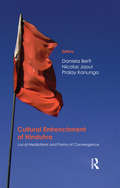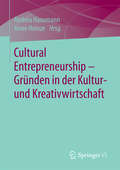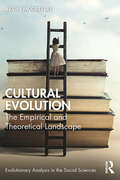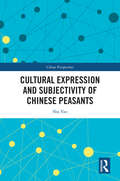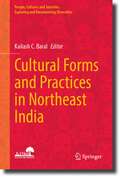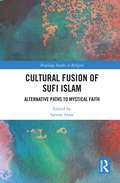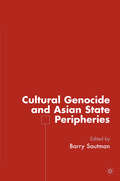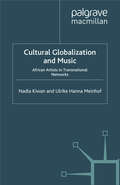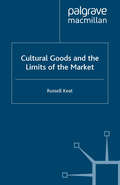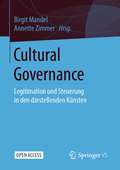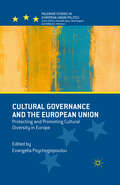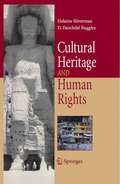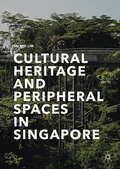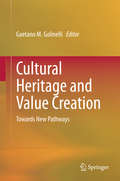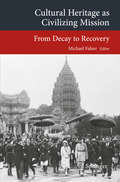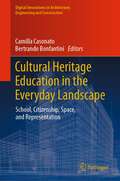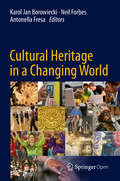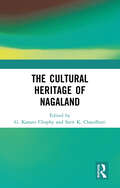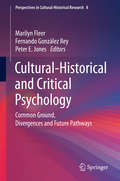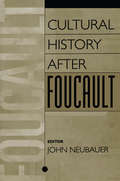- Table View
- List View
Cultural Entrenchment of Hindutva: Local Mediations and Forms of Convergence
by Daniela Berti Nicolas Jaoul Pralay KanungoThe book reflects on the discreet influence of Hindutva in situations/places outside or at the margins of its organisational and mobilisational arena, where people denying any commitment to the Sangh Parivar, incidentally, show affinities and parallelisms with its discourse and practice. This study looks at Hindutva’s entrenchment not so much as an orchestration from above but more as an outcome of a process that evolves in relation to specific social and cultural milieus.The contributors analyse Hindutva’s entrenchment, emphasising on the ethnography of the forms of mediation and/or convergence produced in certain contexts. The 11 case studies highlight three different dynamics of Hindutva’s cultural entrenchment. The first section gathers cases where RSS-affiliated organisations have set up specific cultural or artistic programmes at the regional level, involving the meditation of local people whose interest in these programmes does not necessarily mean that they endorse the Hindutva agenda completely. The next deals with convergence and refers to cases where the followers gather around a charismatic personality, whose precepts and practice may bring them towards a closer affinity with the Hindutva programme. The last section deals with the contexts of resistance, where social milieus engaged in opposing Hindutva may, in fact, paradoxically, and even inadvertently, imbibe some of its ideas and practices in order to contest its claims.
Cultural Entrepreneurship – Gründen in der Kultur- und Kreativwirtschaft
by Andrea Hausmann Anne HeinzeDer vorliegende Sammelband hat das Ziel, die Besonderheiten von Gründungen in der Kultur- und Kreativwirtschaft auszuloten und Maßnahmen und Lösungsansätze im Hinblick auf Finanzierung, Förderung, Marketing und Netzwerkmanagement vorzustellen. Renommierte Experten aus Wissenschaft und Praxis beleuchten Chancen und Risiken für Gründungen in der Kultur- und Kreativwirtschaft. Best-Practice-Beispiele und Tipps für erfolgreiche Gründungen runden die Inhalte des Sammelbandes ab.
Cultural Essentialism in Intercultural Relations (Frontiers of Globalization)
by Fred Dervin Regis MachartThe concept of culture has long been criticized, with many scholars reformulating it or discarding it entirely. The field of intercultural communication and relations, however, still relies on culture to examine interculturality and this volume provides a comprehensive examination of the problems that the concept poses today.
Cultural Evolution: The Empirical and Theoretical Landscape (Evolutionary Analysis in the Social Sciences)
by Kevin McCaffreeSince the dawn of social science, theorists have debated how and why societies appear to change, develop and evolve. Today, this question is pursued by scholars across many different disciplines and our understanding of these dynamics has grown markedly. Yet, there remain important areas of disagreement and debate: what is the difference between societal change, development and evolution? What specific aspects of cultures change, develop or evolve and why? Do societies change, develop or evolve in particular ways, perhaps according to cycles, or stages or in response to survival necessities? How do different disciplines—from sociology to anthropology to psychology and economics—approach these questions? This book provides complex and nuanced answers to these, and many other, questions. First, the book invites readers to consider the broad landscape of societal dynamics across human history, beginning with humanity’s origins in small nomadic bands of hunter gatherers through to the emergence of post-industrial democracies. Then, the book provides a tour of several prominent existing theories of cultural change, development and evolution. Approaches to explaining cultural dynamics will be discussed across disciplines and schools of thought, from "meme" theories to established cumulative cultural evolutionary theories to newly emerging theories on cultural tightness-looseness. The book concludes with a call for theoretical integration and a frank discussion of some of the most unexamined structures that drive cultural dynamics across schools of thought.
Cultural Evolution: The Empirical and Theoretical Landscape (Evolutionary Analysis in the Social Sciences)
by Kevin McCaffreeSince the dawn of social science, theorists have debated how and why societies appear to change, develop and evolve. Today, this question is pursued by scholars across many different disciplines and our understanding of these dynamics has grown markedly. Yet, there remain important areas of disagreement and debate: what is the difference between societal change, development and evolution? What specific aspects of cultures change, develop or evolve and why? Do societies change, develop or evolve in particular ways, perhaps according to cycles, or stages or in response to survival necessities? How do different disciplines—from sociology to anthropology to psychology and economics—approach these questions? This book provides complex and nuanced answers to these, and many other, questions. First, the book invites readers to consider the broad landscape of societal dynamics across human history, beginning with humanity’s origins in small nomadic bands of hunter gatherers through to the emergence of post-industrial democracies. Then, the book provides a tour of several prominent existing theories of cultural change, development and evolution. Approaches to explaining cultural dynamics will be discussed across disciplines and schools of thought, from "meme" theories to established cumulative cultural evolutionary theories to newly emerging theories on cultural tightness-looseness. The book concludes with a call for theoretical integration and a frank discussion of some of the most unexamined structures that drive cultural dynamics across schools of thought.
Cultural Expression and Subjectivity of Chinese Peasants (China Perspectives)
by Sha YaoAs the famous sociologist Fei Xiaotong argued, “the real life of most Chinese can only be seen in the villages.” Peasants not only comprise a significant part of the Chinese population but represent a distinctive culture and one that is expressed in its own particular way. This makes for an important area of study for scholars in communication studies. This volume investigates how Chinese peasants express their culture and adapt to social change. The author’s research consists of participant observation and interviews of shadow puppetry artists in Guanzhong, China, illustrating how peasant artists have adapted to the historical and social changes since the founding of the People’s Republic of China. He discovers that Chinese peasants integrate urban popular culture with their own aesthetic criteria, even if the mainstream discourse of the Chinese community overlooks the subjectivity of peasants. He goes on to put forwards a creative analytical framework for the studies of the dynamics of “subject-time-space.” Scholars and students of anthropology, sociology, and communication studies, especially rural communication studies, will find this an ideal case study.
Cultural Expression and Subjectivity of Chinese Peasants (China Perspectives)
by Sha YaoAs the famous sociologist Fei Xiaotong argued, “the real life of most Chinese can only be seen in the villages.” Peasants not only comprise a significant part of the Chinese population but represent a distinctive culture and one that is expressed in its own particular way. This makes for an important area of study for scholars in communication studies. This volume investigates how Chinese peasants express their culture and adapt to social change. The author’s research consists of participant observation and interviews of shadow puppetry artists in Guanzhong, China, illustrating how peasant artists have adapted to the historical and social changes since the founding of the People’s Republic of China. He discovers that Chinese peasants integrate urban popular culture with their own aesthetic criteria, even if the mainstream discourse of the Chinese community overlooks the subjectivity of peasants. He goes on to put forwards a creative analytical framework for the studies of the dynamics of “subject-time-space.” Scholars and students of anthropology, sociology, and communication studies, especially rural communication studies, will find this an ideal case study.
Cultural Forms and Practices in Northeast India (People, Cultures and Societies: Exploring and Documenting Diversities)
by Kailash C. BaralThe present book examines cultural diversities of Northeast India. The sixteen essays included in the volume cover various aspects of cultural forms and their practices among the communities of Northeast. The present volume is expected to serve as a bridge between vanishing cultural forms and their commodification, on the one hand, and their cultural ritual origins, evolution and significance in identity formation, on the other. The book analyses continuity of cultural forms, their representations and often their reinventions under globalisation. Further, the book underlines historical forces such as colonialism and religious conversion that have transformed communities and their cultural practices. Yet some of the pre-colonial, ritual-performative traditions hold on. Through insightful analyses, this book offers an informed view of the region’s historical, ethnic and cultural practices. It is expected that the volume will be useful for scholars and students interested in Northeast studies.
Cultural Fusion of Sufi Islam: Alternative Paths to Mystical Faith (Routledge Studies in Religion)
by Sarwar AlamIt has been argued that the mystical Sufi form of Islam is the most sensitive to other cultures, being accommodative to other traditions and generally tolerant to peoples of other faiths. It readily becomes integrated into local cultures and they are similarly often infused into Sufism. Examples of this reciprocity are commonly reflected in Sufi poetry, music, hagiographic genres, memoires, and in the ritualistic practices of Sufi traditions. This volume shows how this often-side-lined tradition functions in the societies in which it is found, and demonstrates how it relates to mainstream Islam. The focus of this book ranges from reflecting Sufi themes in the Qur’anic calligraphy to movies, from ideals to everyday practices, from legends to actual history, from gender segregation to gender transgression, and from legalism to spiritualism. Consequently, the international panel of contributors to this volume are trained in a range of disciplines that include religious studies, history, comparative literature, anthropology, and ethnography. Covering Southeast Asia to West Africa as well as South Asia and the West, they address both historical and contemporary issues, shedding light on Sufism’s adaptability. This book sets aside conventional methods of understanding Islam, such as theological, juridical, and philosophical, in favour of analysing its cultural impact. As such, it will be of great interest to all scholars of Islamic Studies, the Sociology of Religion, Religion and Media, as well as Religious Studies and Area Studies more generally.
Cultural Fusion of Sufi Islam: Alternative Paths to Mystical Faith (Routledge Studies in Religion)
by Sarwar AlamIt has been argued that the mystical Sufi form of Islam is the most sensitive to other cultures, being accommodative to other traditions and generally tolerant to peoples of other faiths. It readily becomes integrated into local cultures and they are similarly often infused into Sufism. Examples of this reciprocity are commonly reflected in Sufi poetry, music, hagiographic genres, memoires, and in the ritualistic practices of Sufi traditions. This volume shows how this often-side-lined tradition functions in the societies in which it is found, and demonstrates how it relates to mainstream Islam. The focus of this book ranges from reflecting Sufi themes in the Qur’anic calligraphy to movies, from ideals to everyday practices, from legends to actual history, from gender segregation to gender transgression, and from legalism to spiritualism. Consequently, the international panel of contributors to this volume are trained in a range of disciplines that include religious studies, history, comparative literature, anthropology, and ethnography. Covering Southeast Asia to West Africa as well as South Asia and the West, they address both historical and contemporary issues, shedding light on Sufism’s adaptability. This book sets aside conventional methods of understanding Islam, such as theological, juridical, and philosophical, in favour of analysing its cultural impact. As such, it will be of great interest to all scholars of Islamic Studies, the Sociology of Religion, Religion and Media, as well as Religious Studies and Area Studies more generally.
Cultural Genocide and Asian State Peripheries
by B. SautmanThis volume engages the concept and related notions of cultural hegemony, cultural erosion, cultural hybridity and cultural survival by considering whether five regimes in Asia deploy policies aimed at extirpating the language, religion, arts, customs or other elements of the cultures of non-dominant peoples.
Cultural Globalization and Music: African Artists in Transnational Networks
by Nadia Kiwan Ulrike Hanna MeinhofThis book is about South-North, North-South relations between Africa and Europe, presenting the personal narratives of musicians in different locations across Africa and Europe, and those of the people who constitute their networks within the wider artistic, cultural, and civil society milieus of globalizing societies.
Cultural Goods and the Limits of the Market
by R. KeatIn Cultural Goods and the Limits of the Market , Russell Keat presents a theoretical challenge to recent extensions of the market domain and the introduction of commercially modelled forms of organization in areas such as broadcasting, the arts and academic research. Drawing on Walzer's pluralistic conception of social goods, and MacIntyre's account of social practices, he argues that cultural activities of this kind, and the institutions within which they are conducted, can best make their distinctive contributions to human well-being when protected from the damaging effects of an unbounded market.
Cultural Governance: Legitimation und Steuerung in den darstellenden Künsten
by Birgit Mandel Annette ZimmerIm internationalen Vergleich verfügt Deutschland über einen bemerkenswerten Theatersektor im Hinblick auf Ensembles und Spielstätten. Die darstellenden Künste sind zudem der Kulturbereich mit der höchsten öffentlichen Förderung. Theater ist daher in besonderer Weise abhängig von der Politik. Was bedeutet das für den Alltag der Theatermacher*innen? Wie und mit welchen Zielsetzungen greift Kulturpolitik in die darstellenden Künste ein? Welche Governance-Strukturen lassen sich erkennen? Antworten auf diese Fragen geben Ergebnisse der DFG-Forschungsgruppe „Krisengefüge der Künste“, die das Zusammenspiel von Politik, Organisation und künstlerischer Produktion untersucht. Die Beiträge dieses Open Access Buches decken ein breites Themenspektrum ab, das von Fallbeispielen kulturpolitischer Governance und Legitimationsstrategien einzelner Häuser, über empirische Studien zur Beschäftigungssituation und zur Wahrnehmung von Theater in der Bevölkerung bis hin zu Analysen ästhetischer Neu-Formatierungen reicht.Die HerausgeberinnenDr. Birgit Mandel ist Professorin für Kulturvermittlung und Kulturmanagement am Institut für Kulturpolitik der Universität Hildesheim.Dr. Annette Zimmer ist Professorin für Deutsche und Europäische Sozialpolitik und Vergleichende Politikwissenschaft am Institut für Politikwissenschaft der Westfälischen Wilhelms-Universität Münster.
Cultural Governance and the European Union: Protecting and Promoting Cultural Diversity in Europe (Palgrave Studies in European Union Politics)
by Evangelia PsychogiopoulouThis edited collection brings together distinguished scholars across a range of academic disciplines to explore how the European Union engages with culture. The book examines the ways in which cultural issues have been framed at the EU level and the policies and instruments to which they have given vent.
Cultural Heritage and Human Rights
by Helaine Silverman D. Fairchild RugglesIs there a universal right to the free expression and preservation of cultural heritage, and if so, where is that right articulated and how can it be protected? No corner of today’s world has escaped the effects of globalization – for better or worse. This volume addresses a deeply political aspect of heritage preservation and management as it relates to human rights.
Cultural Heritage and Peripheral Spaces in Singapore
by Tai Wei LimThis book documents through first-hand experience and academic research the historical, cultural and economic interactions affecting land use in Singapore. Offering a unique study of nostalgia in Singaporean heritage, it discusses the subjective nostalgic meanings and interpretations that users of peripheral, heritage and green spaces in Singapore create and maintain, through a combination of informal observations and interactions combined with research into local history and heritage. It addresses the subjective meaning-making processes of individuals within the larger theoretical frameworks that structure understandings of changing land use and economical changes which impact on contemporary cityscapes, centered around peripheral and de-privileged areas of Singapore’s economic development.
Cultural Heritage and Value Creation: Towards New Pathways
by Gaetano M. GolinelliInformed by systems thinking, this book explores new perspectives in which culture and management are harmoniously integrated and cultural heritage is interpreted both as an essential part of the social and economic context and as an expression of community identity. The combination of a multidisciplinary approach, methodological rigor and reference to robust empirical findings in the fertile field of analysis of UNESCO’s contribution mean that the book can be considered a reference for the management of cultural heritage. It casts new light on the complex relation of culture and management, which has long occupied both scholars and practitioners and should enable the development of new pathways for value creation. The book is based on research conducted within the framework of the Consorzio Universitario di Economia Industriale e Manageriale (University Consortium for Industrial and Managerial Economics), a network of universities, businesses and public and private institutions that is dedicated to the production and dissemination of knowledge in the field. This volume will be of interest to all who are involved in the study and management of the cultural heritage.
Cultural Heritage as Civilizing Mission: From Decay to Recovery (Transcultural Research – Heidelberg Studies on Asia and Europe in a Global Context)
by Michael FalserThis book investigates the role of cultural heritage as a constitutive dimension of different civilizing missions from the colonial era to the present. It includes case studies of the Habsburg Empire and German colonialism in Africa, Asian case studies of (post)colonial India and the Dutch East Indies/Indonesia, China and French Indochina, and a special discussion on 20th-century Cambodia and the temples of Angkor.The themes examined range from architectural and intellectual history to historic preservation and restoration. Taken together, they offer an overview of historical processes spanning two centuries of institutional practices, wherein the concept of cultural heritage was appropriated both by political regimes and for UNESCO World Heritage agendas.
Cultural Heritage Education in the Everyday Landscape: School, Citizenship, Space, and Representation (Digital Innovations in Architecture, Engineering and Construction)
by Camilla Casonato Bertrando BonfantiniThis book summarizes work being undertaken within the School Activates Resources—stitching the lost heritage of the suburbs (ScAR) project, which addressed cultural heritage in a broad sense, as a system of values identified by the populations and in constant evolution. This tangible and intangible heritage fuels the promotion of intergenerational and intercultural dialogue and represents an opportunity for resilient social and territorial development. The book ponders the experience gained and the points of view of the different disciplines involved, examines issues such as children and youth participation in civil life or education in cultural heritage and landscape, and presents real-world experiences of heritage education in everyday landscape in difficult contexts and/or concerning poorly recognized and valued cultural heritage.
Cultural Heritage in a Changing World
by Karol Jan Borowiecki Neil Forbes Antonella FresaThe central purpose of this collection of essays is to make a creative addition to the debates surrounding the cultural heritage domain. In the 21st century the world faces epochal changes which affect every part of society, including the arenas in which cultural heritage is made, held, collected, curated, exhibited, or simply exists. The book is about these changes; about the decentring of culture and cultural heritage away from institutional structures towards the individual; about the questions which the advent of digital technologies is demanding that we ask and answer in relation to how we understand, collect and make available Europe’s cultural heritage. Cultural heritage has enormous potential in terms of its contribution to improving the quality of life for people, understanding the past, assisting territorial cohesion, driving economic growth, opening up employment opportunities and supporting wider developments such as improvements in education and in artistic careers. Given that spectrum of possible benefits to society, the range of studies that follow here are intended to be a resource and stimulus to help inform not just professionals in the sector but all those with an interest in cultural heritage.
The Cultural Heritage of Nagaland
by G. Kanato Chophy Sarit K. ChaudhuriThis volume gives an in-depth account of cultural heritage of Nagaland covering important themes like cultural beliefs, traditional knowledge, material culture, and social institutions. Contributors from diverse disciplines and backgrounds have delved into the cultural heritage of the state’s variegated tribes. Nagaland a hilly state in North-East India had been the centre of British colonialism and American Baptist mission. This cultural contact is significantly reflected in the socio-cultural life, and the contributors have shed light on the continuities and changes. This volume highlights the multiplicity of cultural traditions that are specific to various tribes inhabiting sixteen districts of Nagaland, since their experiences of modernity and cultural contact with ‘others’ have been diverse. The contributors have mainly focussed on the cultural heritage of the majority Naga tribes, but other tribes like the Kukis and Kacharis are part and parcel of the cultural melting pot of Nagaland, and this volume in a way underscores the cultural exchange and interactions. Taylor & Francis does not sell or distribute the print version of this book in India, Pakistan, Nepal, Bhutan, Bangladesh and Sri Lanka.
The Cultural Heritage of Nagaland
by G. Kanato Chophy Sarit K. ChaudhuriThis volume gives an in-depth account of cultural heritage of Nagaland covering important themes like cultural beliefs, traditional knowledge, material culture, and social institutions. Contributors from diverse disciplines and backgrounds have delved into the cultural heritage of the state’s variegated tribes. Nagaland a hilly state in North-East India had been the centre of British colonialism and American Baptist mission. This cultural contact is significantly reflected in the socio-cultural life, and the contributors have shed light on the continuities and changes. This volume highlights the multiplicity of cultural traditions that are specific to various tribes inhabiting sixteen districts of Nagaland, since their experiences of modernity and cultural contact with ‘others’ have been diverse. The contributors have mainly focussed on the cultural heritage of the majority Naga tribes, but other tribes like the Kukis and Kacharis are part and parcel of the cultural melting pot of Nagaland, and this volume in a way underscores the cultural exchange and interactions. Taylor & Francis does not sell or distribute the print version of this book in India, Pakistan, Nepal, Bhutan, Bangladesh and Sri Lanka.
Cultural-Historical and Critical Psychology: Common Ground, Divergences and Future Pathways (Perspectives in Cultural-Historical Research #8)
by Marilyn Fleer Fernando González Rey Peter E. JonesThis book opens up a critical dialogue within and across the theoretical traditions of critical psychology and cultural-historical psychology. It explores and addresses fundamental issues and problems within both traditions, with a view to identifying new avenues for productive discussion and cooperation between these two important movements in contemporary psychology. Accordingly, the book gathers contributions from a range of internationally respected researchers from both fields who have demonstrated a willingness to look critically, and self-critically, at their theoretical allegiances and trajectories. This book provides readers with the opportunity to both appreciate and reflect on fundamental differences of perspective across the ‘cultural-historical’/’critical’ psychology divide and, thereby, to consider and debate key issues facing the discipline of psychology more generally.
Cultural History After Foucault
by John NeubauerBoth as historian and maker of culture, Foucault infused numerous disciplines of study with a new conceptual vocabulary and an agenda for future research. His ideas have called central assumptions in Western culture into question and altered the ways in which scholars and social scientists approach such issues as discourse theory, theory of knowledge, Eros, technologies of the Self and Other, punishment and prisons, and asylums and madness.The contributors to this volume indicate Foucault's achievements and the suggestive power of his work, as well as his methodological weaknesses, historical inaccuracies, and ambiguities. Above all, they attempt to show how one can use Foucault to go beyond him in opening new approaches to cultural history. Though comprehensiveness was not attempted, their essays broach the major controversial aspects of Foucauldian cultural history--the position of the subject, the fusion of power and knowledge, sexuality, the historical structures and changes--and they explicitly analyze them with respect to antiquity, the Renaissance, and the nineteenth century.In this collection, Neubauer presents analyses by historians, literary scholars, and philosophers of the entire, transdisciplinary range of Foucault's oeuvre, emphasizing the rich suggestiveness of its agenda. The breadth of the undertaking makes it suitable for seminars and graduate courses in numerous departments.
